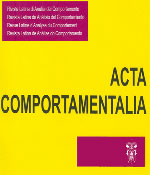Um teste de simetria após treino de discrimínaçôes condicionais de posiçâo com macaco Ateles paniscus paniscus
Contenido principal del artículo
Resumen
A líleratura da área de equivalêncía de estímulos relata freqüentemente a dífículdade de obtençâo de relaçôes de equivalêncía e de suas relaçôes definidoras, especialmente símetría e transitividade, com nâo-humanos. Urna hípótese levantada na literatura da área é que a posíçâo dos estímulos assume papel controlador, difícultando a tarefa para esses sujeitos. O estudo da própria posiçâo como estímulo se torna entáo relevante. O presente experimento objetivou verificar se simetria pode ser obtida a partir de um treino de trés relaçôes entre posíçôes. Um macaco Ateles paniscus paniscus experimentalmente ingênuo foi utilizado como sujeito e um procedímento de pareamento com o modelo foi usado para treino das relacóes. O experimento constou de 4 fases: 1) treino ao bebedouro, 2) modelagem da resposta de pressâo às chaves do painel, 3) treino das relaçôes condicionais, onde inicialmente apenas a estímulo modelo e a comparaçâo correta estavam presentes e depois as comparaçôes erradas eram introduzidas progressivamente, 4) teste de simetria. Os resultados mostraram que simetría nâo foi obtida. No teste, a sujeito respondeu do modo mais semelhante ao treino quanto possível, demonstrando novas relaçôes entre posíçôes muito parecidas com as relaçôes treinadas. A posiçâo como estímulo nâo facilitou a emergencia da simetria. Os dados apontam para a possível necessidade de reformulaçâo da linha de base, com o objetivo de garantir controle condicional, ou treino da simetria, seguido de treinos de novas linhas de base e noves testes até uma possível emergência.
Detalles del artículo
Citas en Dimensions Service

<a rel="license" href="http://creativecommons.org/licenses/by-nc-sa/4.0/"><img alt="Licencia de Creative Commons" style="border-width:0" src="https://i.creativecommons.org/l/by-nc-sa/4.0/88x31.png" /></a><br />Este obra está bajo una <a rel="license" href="http://creativecommons.org/licenses/by-nc-sa/4.0/">licencia de Creative Commons Reconocimiento-NoComercial-CompartirIgual 4.0 Internacional</a>.
